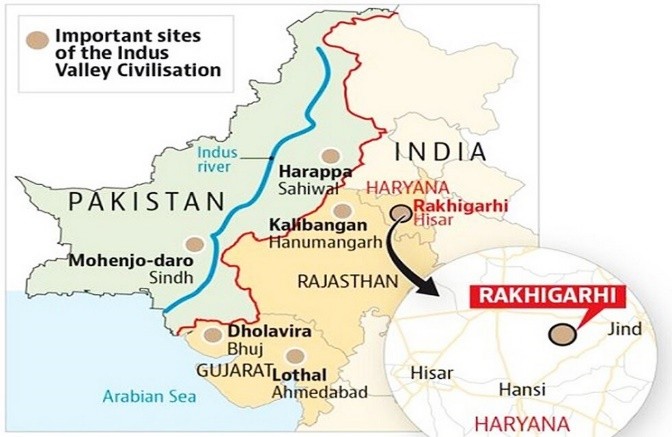Dholavira

- 05 Mar 2025
In News:
President DroupadiMurmu recently visited Dholavira, a UNESCO World Heritage Site located in Gujarat, India. She expressed appreciation for the Archaeological Survey of India’s (ASI) meticulous conservation efforts to preserve this ancient site, despite its remote location.
Location and Significance:
Dholavira is situated on Khadir Bet Island in the Great Rann of Kutch, Gujarat, within the Kutch Desert Wildlife Sanctuary and along the Tropic of Cancer. It was inscribed as a UNESCO World Heritage Site in 2021 due to its remarkable contributions to understanding the Harappan (Indus Valley) Civilization, one of the world's earliest urban cultures.
Key Features:
- City Layout and Construction:Dholavira is distinct from other Harappan sites in its layout, divided into three main sections: the Citadel, the Middle Town, and the Lower Town. The city is unique for its extensive use of stone in construction, unlike the brick-built cities of Harappa and Mohenjo-Daro. It also featured multi-purpose grounds, including a marketplace and a festive area.
- Water Conservation System:The site is renowned for its sophisticated water management techniques, which included 16 massive reservoirs, stepwells, check dams, and underground water storage systems. This advanced water conservation system earned it the name "Jal Durga" or "Water Fort." The engineering skills of the Harappans, especially in water harvesting, were far ahead of their time and continue to be admired today.
- Trade and Cultural Exchange:Dholavira was a significant trade hub, connected to regions such as Magan (modern Oman) and Mesopotamia. It is believed to have been involved in the trade of copper, jewelry, and timber. The site yielded a variety of artifacts, including terracotta pottery, seals, ornaments, and evidence of metallurgy, along with inscriptions in the Indus Valley script.
- Archaeological Discoveries:The site was first discovered by Jagat Pati Joshi in 1967 and excavated systematically between 1990 and 2005 under Dr. Ravindra Singh Bisht of ASI. It is the fifth-largest site of the Indus Valley Civilization and provides evidence of habitation over seven cultural phases from 3000 to 1500 BCE. Notably, no human remains have been found, but the presence of architectural structures, artifacts, and inscriptions gives a rich understanding of the ancient civilization's culture and economy.
- Technological Advancements:The President, during her visit, highlighted the technological advancements of the Harappans, particularly in urban planning and water management, which were superior in many respects to the technology of modern times.
Historical Context:
The Harappan Civilization, flourishing from around 3300 to 1300 BCE along the Indus River, was an urban society known for its advanced city planning, sanitation systems, and trade networks. Dholavira stands out as a crucial link in understanding the broader scope of this civilization. Other key Harappan sites include Harappa, Mohenjo-Daro, Banawali, Lothal, and Ropar.
